Look up! Your guide to some of the best meteor showers for 2018
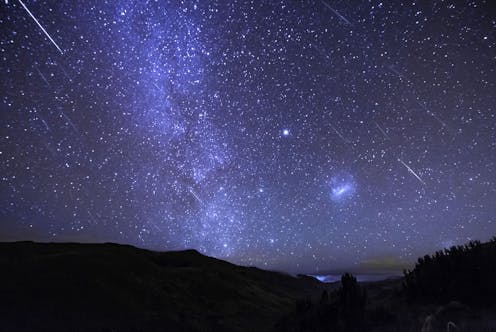 The 2017 Geminids as seen from Ecuador, against the backdrop of the splendid Milky Way (centre) and the Large Magellanic Cloud (right).Flickr/David Meyer, CC BY-NC-ND
The 2017 Geminids as seen from Ecuador, against the backdrop of the splendid Milky Way (centre) and the Large Magellanic Cloud (right).Flickr/David Meyer, CC BY-NC-NDThis year gets off to a relatively slow start when it comes to seeing the annual major meteor showers.
The Quadrantids, one of the big three annual showers, are lost to the vagaries of the full Moon in early January.
But the year’s other two most active annual showers – the Perseids (in August) and Geminids (in December) – are set to put on fine displays.
So when and where should you look to have the best chance of seeing nature’s fireworks?
Here we present the likely meteoric highlights of 2018. These are the meteor showers most likely to put on a good show this year.
Read more:Stars that vary in brightness shine in the oral traditions of Aboriginal Australians
For each shower, we give the forecast activity period and the predicted time of maximum. We also provide charts showing you where to look, and give the peak rates that could be seen under perfect conditions (known as the maximum Zenithal Hourly Rate, or ZHR).
The actual rate you see will always be lower than this value - but the higher a shower’s radiant in the sky and the darker the conditions, the closer the observed rate will get to this ideal value.
To see the best rates it is well worth trying to find a good dark site, far from street lights. Once outside, make sure to give your eyes plenty of time to adapt to the darkness (at least half an hour).
Showers that can only be seen from one hemisphere are denoted by either [N] or [S], with those that can be seen globally marked as [N/S].
Lyrids [N/S; N favoured]
Active: April 14-30
Maximum: April 22, 6pm UT = April 23, 2am AWST (WA) = 4am AEST (QLD/NSW/ACT/Vic/Tas)
ZHR: 18+
Parent: Comet C/1861 G1 (Thatcher)
The Lyrids hold the record for the shower with the longest recorded history, having been observed since at least 687BC.
That longevity is linked to the orbit of the Lyrid’s parent comet, discovered in 1861 by A. E. Thatcher. Comet Thatcher moves on a highly inclined, eccentric orbit, swinging through the inner Solar system every 415 years or so. Its most recent approach to Earth was in 1861.
Compared with many other comets, Thatcher’s orbit is relatively stable, as the only planet with which it can experience close encounters is Earth. This means the meteors it sheds continue to follow roughly the same orbit.
Over the millennia, that shed debris has spread all around the comet’s vast orbit, meaning that for thousands of years, every time Earth intersects Comet Thatcher’s orbit, the Lyrids have been seen, as regular as clockwork.
One study of the orbits of Lyrid meteors even suggests the shower may have been active for at least a million years.
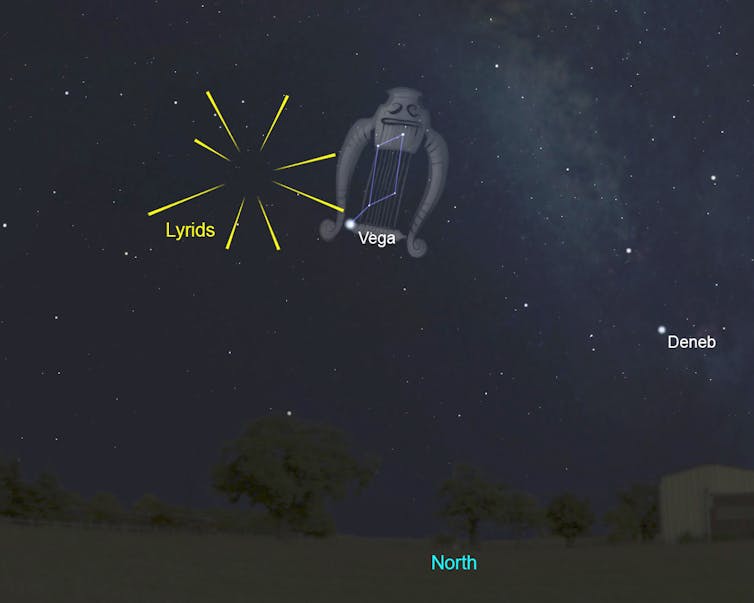 Across Australia, the Lyrids are best seen an hour before sunrise, when the radiant is at its highest [Brisbane 5am].Museums Victoria/stellarium
Across Australia, the Lyrids are best seen an hour before sunrise, when the radiant is at its highest [Brisbane 5am].Museums Victoria/stellariumThese days, the Lyrids are usually a moderately active shower, producing somewhere between 10 and 20 fast, bright meteors per hour at their peak. Occasionally, though, the Lyrids have thrown up a surprise, with rates climbing far higher for a period of several hours.
The best of those outbursts seem to occur every 60 years or so, with the most recent occurring in 1982 when observed rates reached or exceeded 90 per hour.
No such outburst is predicted for 2018, but even in quiet years, the Lyrids are still a fun shower to observe.
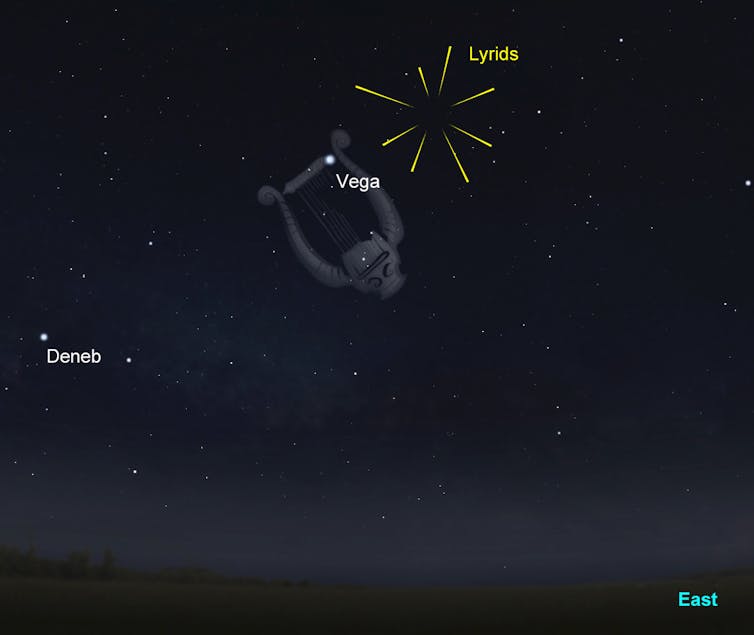 From the USA, the radiant is well placed from late evening until early morning [Chicago 11pm].Museums Victoria/stellarium
From the USA, the radiant is well placed from late evening until early morning [Chicago 11pm].Museums Victoria/stellariumThey are best seen from northern latitudes, but their radiant is far enough south for observers throughout Australia to observe them in the hours before dawn.
For observers at mid-northern latitudes, the Lyrid radiant reaches suitable altitude by about 11pm local time. Viewers in the southern hemisphere have to wait until the early hours of the morning before reasonable rates can be observed.
The forecast time of maximum this year favours observers in Australia and east Asia but the timing of maximum has been known to vary somewhat, so observers around the globe will likely be keeping their eyes peeled, just in case!
Perseids [N]
Active: July 17 - August 24
Maximum: August 12, 8pm UT - August 13, 8am UT = from August 12, 9pm BST (UK) = 10pm CEST (Europe) = 6pm EDT (East Coast, US) = 3pm PDT (West Coast, US) for 12 hours
ZHR: 110
Parent: Comet 109P/Swift-Tuttle
For observers in the northern hemisphere, the Perseids are a spectacular summer highlight. At their peak, rates often reach or exceed 100 meteors per hour, and they are famed for their frequent spectacular fireballs.
The Perseids are probably the best known and most widely observed of all modern meteor showers. They are remarkably consistent, with peak rates usually visible for a couple of evenings, and fall in the middle of the northern hemisphere summer holiday season. The warm nights and frequent clear skies at that time of year make the shower a real favourite!
Like the Lyrids, the Perseids have a long and storied history, having been observed for at least 2,000 years. Their parent comet, 109P/Swift-Tuttle, is a behemoth, with the largest nucleus of the known periodic comets - some 26km in diameter.
It has likely moved on its current orbit for tens of thousands of years, all the time laying down the debris that gives us our annual Perseid extravaganza. It will next swing past Earth in 2126 when it will be a spectacular naked eye object.
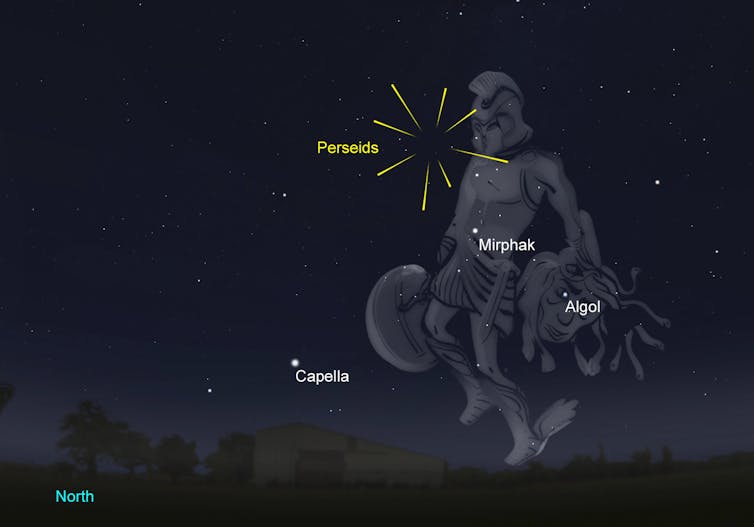 From the UK, the Perseids radiant is visible all night and summer is the perfect time for meteor watching [Greenwich 9pm].Museums Victoria/stellarium
From the UK, the Perseids radiant is visible all night and summer is the perfect time for meteor watching [Greenwich 9pm].Museums Victoria/stellariumThis year the forecast maximum for the Perseids favours observers in Europe, although given the length of peak activity, any location in the northern hemisphere has the potential to see a spectacular show on the night of August 12.
But don’t despair if it’s cloudy that night, as the Perseids have a relatively broad period of peak activity, meaning that good rates can be seen for a few days either side of their peak.
In 2018, the peak of the Perseid shower coincides with the New Moon, and so is totally unaffected by moonlight, which makes this an ideal year to observe the shower.
The further north you are, the earlier the shower’s radiant will be visible. But reasonable rates can typically be seen any time after about 10pm, local time. The later in the night you observe, the better the rates will be, as the radiant climbs higher into the sky.
It is not uncommon for enthusiastic observers to watch the shower until dawn on the night of maximum, seeing several hundred meteors in a single night.
 A fantastic Perseids display from 2016 over Austria.Flickr/Michael Karrer, CC BY-NC
A fantastic Perseids display from 2016 over Austria.Flickr/Michael Karrer, CC BY-NCDraconids [N]
Active: October 6-10
Maximum: October 9, 12:10am UT = 1:10am BST (UK) = 2:10am CEST (Europe)
ZHR: 10+
Parent: Comet 21P/Giacobini-Zinner
The Draconids are a fascinating meteor shower, although in most years, somewhat underwhelming. Unlike the previous showers, the Draconids are a relatively young meteor shower that can vary dramatically from one year to the next.
First observed less than a century ago, the Draconids (also known as the Giaocobinids) are tied to a Jupiter-family comet called 21P/Giacobini-Zinner.
That comet was the first to be visited by a spacecraft, and has frequent close encounters with Jupiter, which continually nudges its orbit around. These encounters also perturb the meteor stream the comet is laying down, sometimes enhancing rates at Earth and sometimes diminishing them.
In the early 20th century, it was realised that Comet Giacobini-Zinner’s orbit comes close enough to Earth that we might be able to see meteors as we plough through the debris it leaves behind.
This led to the first predictions of Draconid activity. Sure enough, in 1920, the great meteor observer W. F. Denning confirmed the existence of the shower, with a mere five meteors observed between October 6 and October 9.
In 1933 and 1946, the Draconids produced two of the greatest meteor displays of the 20th century - great storms, with peak rates of several thousand meteors per hour. In those years, Earth crossed the comet’s orbit just a month or two after the comet passed through perihelion (closest approach to the Sun), and Earth ploughed through dense material in the comet’s wake.
After 1946, the Draconids went quiet, all but vanishing from our skies. Jupiter had swung the comet onto a less favourable orbit. Only a few Draconids were seen in 1972, then again in 1985 and 1998.
The late 1990s saw a renaissance in our ability to predict and understand meteor showers, born of enhanced activity exhibited by the Leonid meteor shower. Using the techniques developed to study the Leonids, astronomers predicted enhanced activity from the Draconids in 2011, and the predicted outburst duly occurred, with rates of around 300 meteors per hour being observed.
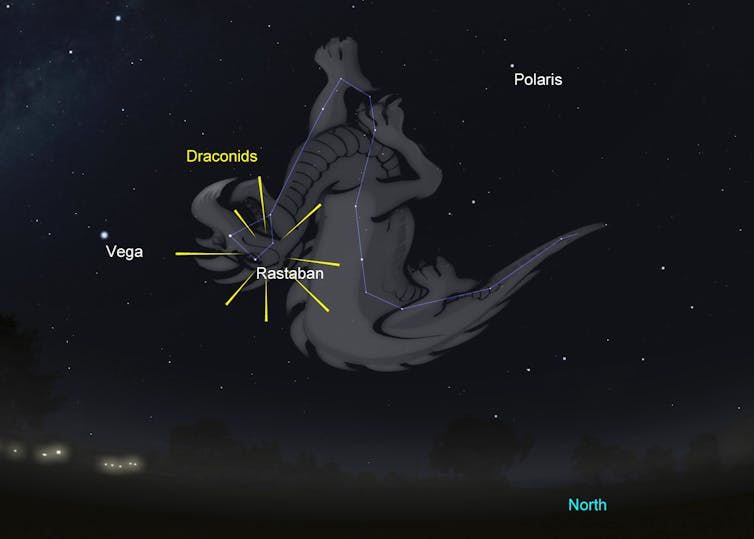 Europe is well placed to catch some Draconids streaming from the eye of the dragon, near the star Rastaban [Paris 12:30am].Museums Victoria/stellarium
Europe is well placed to catch some Draconids streaming from the eye of the dragon, near the star Rastaban [Paris 12:30am].Museums Victoria/stellariumThis year comet Giacobini-Zinner once again passes through perihelion and swings close to Earth’s orbit. The chances are good that the shower will be active - albeit unlikely to produce a spectacular storm.
Modelling suggests that rates of 20 to 50 faint meteors per hour might be seen around 12:14am UT on October 9. Other models suggest that rates will peak about 45 minutes earlier, with lower rates of 15 to 20.
The Draconid radiant is circumpolar (that is, it never sets) for locations north of 44°N, and is highest in the sky before midnight. This year, the Moon is new at the time of the forecast peak, which is ideally timed for observers in Europe.
If skies are clear that evening, it is well worth heading out at around 11:30pm BST on October 8 (12:30am CEST on October 9) and spending a couple of hours staring north, just in case the Draconids put on another spectacular show.
Taurids [N/S]
Active: September 10 - December 10
Maxima: October 10 (Southern Taurids); November 12 (Northern Taurids)
ZHR: 5 + 5
Parent: Comet 2P/Encke
Of all the year’s meteor showers, the one that dumps the greatest amount of dust into Earth’s atmosphere are the Taurids. The inner Solar system contains a vast swathe of debris known as the Taurid stream. It is so spread out that Earth spends a quarter of the year passing through it.
In June, that debris spawns the Daytime Taurid meteor shower, which (as the name suggests) occurs during daylight hours, and is only really known thanks to radio observations.
After leaving the stream for a little while, Earth penetrates it again at the start of September, and activity continues right through until December. Hourly rates fluctuate up and down, with several distinct peaks and troughs through October and November.
The Taurid stream is complex - with at least two main components, known as the northern and southern branches. Typically, the Southern Taurids are active a little earlier in the year and reach their peak about a month before the northern branch.
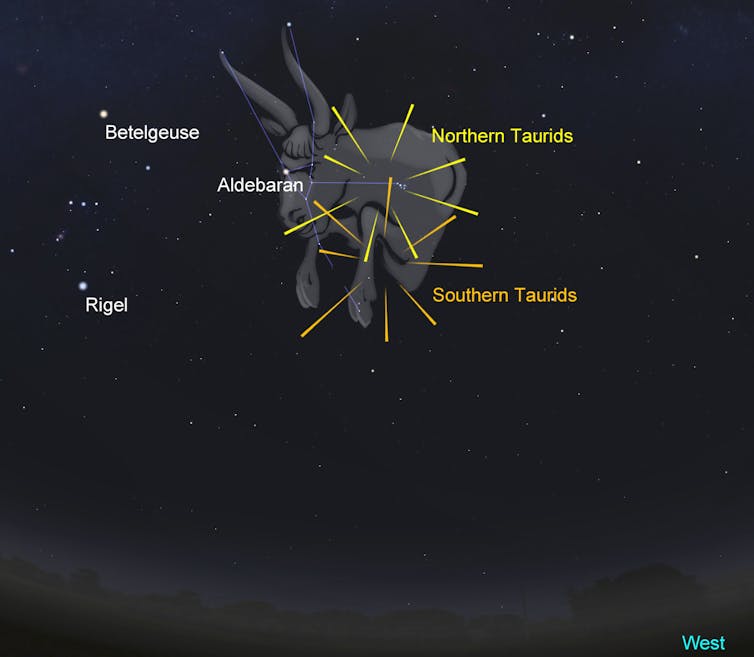 During northern autumn, the Taurids can be seen radiating from the western sky before dawn [Paris 6:30am October 10].Museums Victoria/stellarium
During northern autumn, the Taurids can be seen radiating from the western sky before dawn [Paris 6:30am October 10].Museums Victoria/stellarium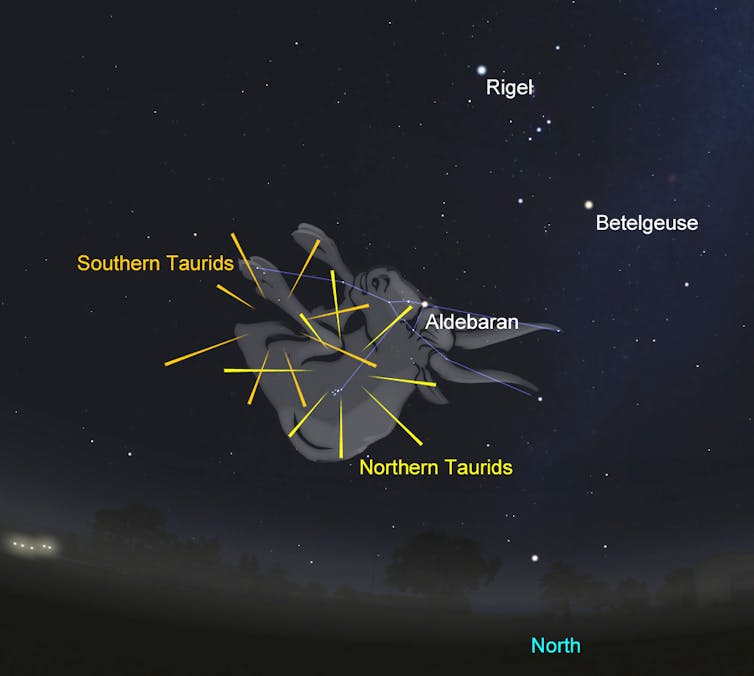 For the southern spring, the Taurids radiate from the northern sky before dawn [Melbourne 3:30am November 12].Museums Victoria/stellarium
For the southern spring, the Taurids radiate from the northern sky before dawn [Melbourne 3:30am November 12].Museums Victoria/stellariumThe Taurids are slow meteors and feature plenty of bright fireballs. So even though their rates are low, they are well worth looking out for, particularly when other showers are also active, such as the Draconids, the Orionids and the Leonids.
Put together, these showers make the northern autumn or the southern spring a great time to get out and look for natural fireworks.
Orionids [N/S]
Active: October 2 - November 7
Maximum: October 21
ZHR: 20+
Parent: Comet 1P/Halley
Twice a year, Earth runs through the stream of debris littered around the orbit of Comet 1P/Halley. Throughout the month of October this gives rise to the Orionid meteor shower.
The Orionids are a fairly reliable meteor shower with a long, broad maximum. Typically, peak rates can last for almost a week, centred on the nominal maximum date. Throughout that week, Orionid rates can fluctuate markedly, leading to a number of distinct maxima and minima.
Orionid meteors are fast - much faster than the Taurids that are active at the same of year. Like the Taurids, they are often bright, the result of the high speed at which the meteoroids hit Earth’s atmosphere.
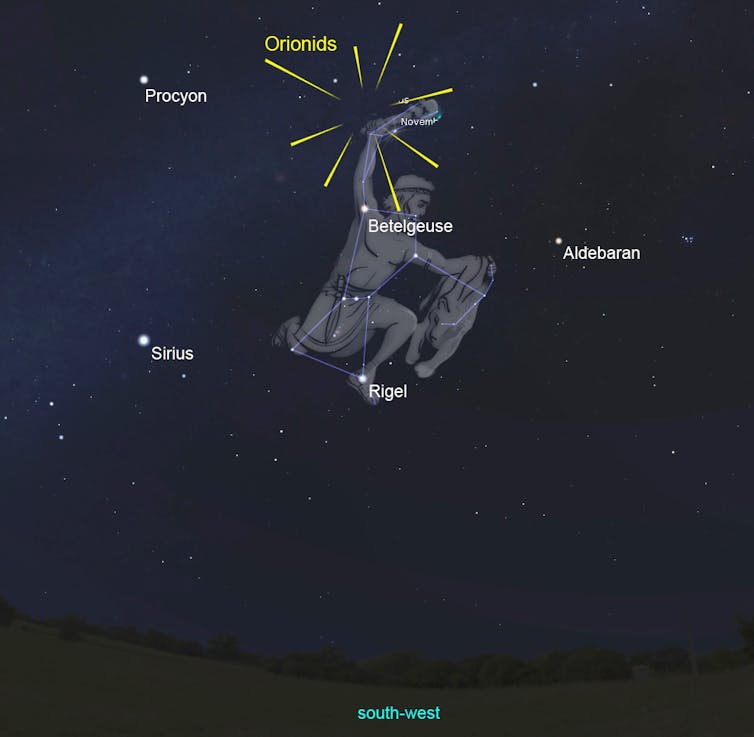 Before sunrise, Orion stands upright in the southwest as seen from the northern hemisphere [Chicago 5am].Museums Victoria/stellarium
Before sunrise, Orion stands upright in the southwest as seen from the northern hemisphere [Chicago 5am].Museums Victoria/stellarium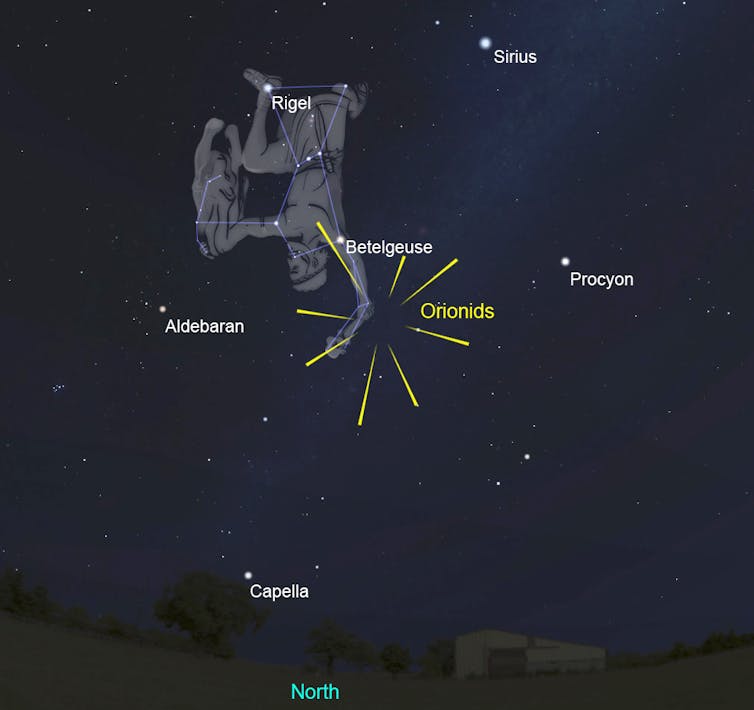 But from the southern hemisphere Orion appears to be standing on his head, in the northern sky before dawn [Sydney 5am].Museums Victoria/stellarium
But from the southern hemisphere Orion appears to be standing on his head, in the northern sky before dawn [Sydney 5am].Museums Victoria/stellariumThe Orionid radiant rises in the late evening and is only really high enough in the sky for reasonable rates to be seen after midnight. As a result, the best rates are usually observed in the hours before dawn.
This works well this year, as the Moon will be in its waxing gibbous phase, setting some time after midnight and leaving the sky dark, allowing us to watch for pieces of the most famous comet of them all.
Geminids [N/S]
Active: December 4-17
Maximum: December 14, 12:30pm UT = Australia: December 14, 8pm AWST (WA) = 10:30pm (QLD) = 11:30pm AEST (NSW/ACT/Vic/Tas) = United States: December 14, 7:30am (EST) = 5:30am (PST) = 2:30am (Hawaii)
ZHR: 120
Parent: Asteroid 3200 Phaethon
As the year comes to a close, we reach the most reliable and spectacular of the annual meteor showers – the Geminids. Unlike the Perseids and the Lyrids, which have graced our skies for thousands of years, the Geminids are a relatively new phenomenon.
They were first observed just 150 years ago, and through the first part of the 20th century were a relatively minor shower. But since then rates have improved decade-on-decade, to the point where they are now the best of the annual showers, bar none.
The reason for their rapid evolution is that their orbit (and that of their parent body, the asteroid Phaethon) is shifting rapidly over time, precessing around the Sun (wobbling like a slow spinning top). As it does so, the centre of Phaethon’s orbit, and the centre of the Geminid stream, are moving ever closer to Earth.
For northern locations, the radiant rises shortly after sunset, and good rates can be seen from mid-evening onwards. For observers in the southern hemisphere, the radiant rises later, so good rates are delayed until later at night (as detailed in our 2015 report on the shower).
Although the time of maximum this year seems to favour observers in the Americas and Australia, peak rates from the Geminids usually last around 24 hours, and so good rates should be visible around the globe.
This year the maximum falls a day before the Moon reaches first quarter so the best rates are visible (after midnight, local time) when the Moon will have set and moonlight will not interfere.
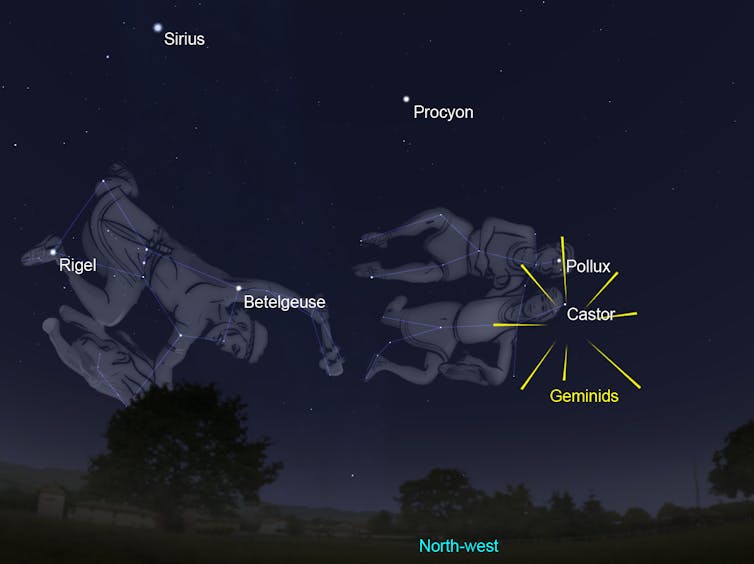 Australia’s summer meteor shower, the consistent and spectacular Geminids in the early morning sky [Brisbane 4am].Museums Victoria/stellarium
Australia’s summer meteor shower, the consistent and spectacular Geminids in the early morning sky [Brisbane 4am].Museums Victoria/stellarium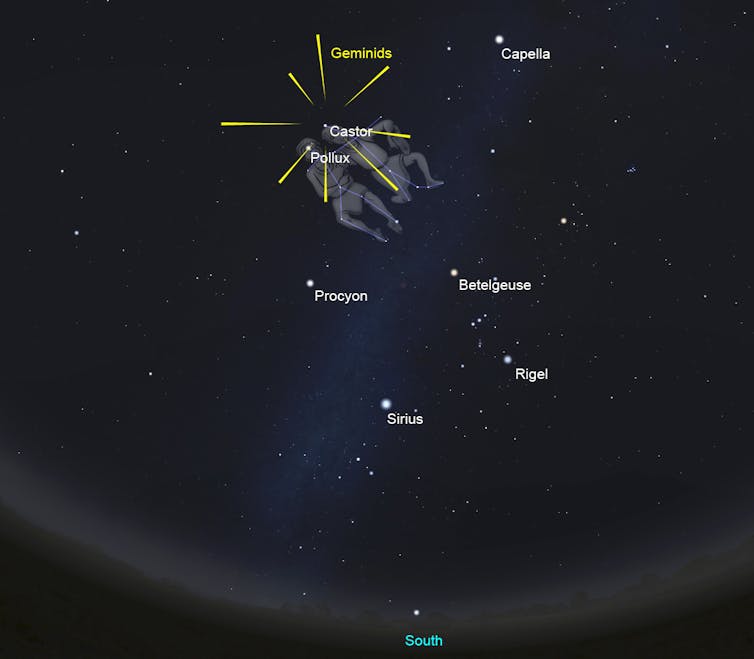 The Geminids appear high overhead over American skies in winter [Los Angeles midnight].Museums Victoria/stellarium
The Geminids appear high overhead over American skies in winter [Los Angeles midnight].Museums Victoria/stellariumGiven that rates from the Geminids continue to climb, the estimated ZHR of 120 is likely to be somewhat conservative. Rates in excess of 130, and even as high as 200 per hour, have been seen in recent years.
Geminids are medium-speed meteors and are often bright. The individual meteors also seem to last just that bit longer than other showers, a fact likely related to their parent object’s rocky nature.
Wherever you are on the planet, the Geminids are a fantastic way to bring the year to an end, and we will hopefully be treated to a magnificent display this year.
The authors do not work for, consult, own shares in or receive funding from any company or organisation that would benefit from this article, and have disclosed no relevant affiliations beyond their academic appointment.
Authors: Jonti Horner, Vice Chancellor's Senior Research Fellow, University of Southern Queensland
Read more http://theconversation.com/look-up-your-guide-to-some-of-the-best-meteor-showers-for-2018-86053





